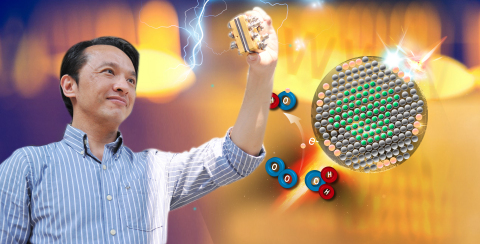Scientists have long been struggling to develop high-performance fuel
cells as environmentally friendly power in electric vehicles. However,
Prof. Chen Tsan-Yao of the Department of Engineering and System Science
(National Tsing Hua University, Taiwan) has recently made a major
breakthrough by using ultrasonic waves to make tiny grooves in the
surface of various materials, which in conjunction with an atomic-scale
platinum catalyst can be used to double the alkaline fuel cells (AFCs)
efficiency.
This press release features multimedia. View the full release here:
https://www.businesswire.com/news/home/20190507005508/en/

Prof. Chen Tsan-Yao recently developed a way of using ultrasonic waves to make tiny grooves on a metal surface, which in conjunction with an atomic-scale platinum catalyst can be used to double the efficiency of alkaline fuel cells. (Photo: National Tsing Hua University)
This atomic-scale catalyst increases the oxygen reduction (cathode
reaction) current intensity by tenfold, with no degradation for eight
months of continuous operation, while reducing the production cost by 90
percent; such cells have a lifespan of two to three years. This
groundbreaking research has been published and selected as a focus paper
of Energy Materials in the February issue of Nature Communications.
Prof. Chen said that he is currently developing a
quantum-size-correlation in catalyst for making cells even cheaper and
more efficient.
Exploring the boundary in atomic scale
A fuel cell is a power generation device to convert chemical energy into
electrical energy. AFCs are safer and more efficient than acid
batteries, and thus are widely used in spacecraft and satellites. The
catalyst is the key component in fuel cell performance. Prof. Chen said
that there are many factors affecting the efficiency of the catalyst,
especially size. At the same volume, the smaller the catalyst particles,
the larger the surface area, and the higher the performance. However, if
the particles are too small, they become unstable and rapidly lose their
efficiency. Thus, Chen’s challenge was to find a way to reduce size and
increase stability.
Inspired from the love of coffee soda
Chen said that coffee soda inspires him in the strategies. In 2016,
while chatting with a coffee shop owner, he discovered that depending on
the order in which the coffee and soda are poured into the glass, the
sweetness, taste, and amount of bubbles are very different. As a result,
he had his research assistants reverse the order in crystal growth.
Unlike the traditional method, they add new materials every ten seconds
and stop the reaction in only seconds, which results in the Pt trimer
catalysts.
Reduced cost, increased efficiency, and extended lifespan
Not surprisingly, Chen’s students initially had some doubts about his
unorthodox approach. With hundreds of failures, they finally made the Pt
trimer catalysts which remained stable while maintaining high activity
in AFCs. Chen said that the amount of platinum used in his atomic
catalyst is only 1%, compared to 35% for the average commercial
catalyst; and the mass current density is increased by 30 times.
View source version on businesswire.com: https://www.businesswire.com/news/home/20190507005508/en/
